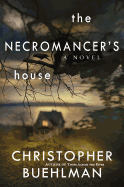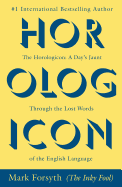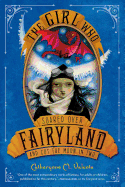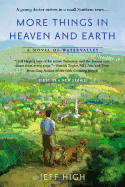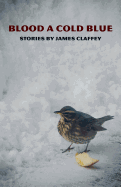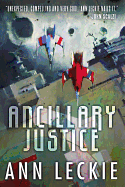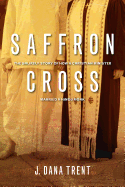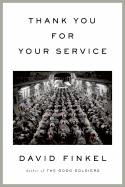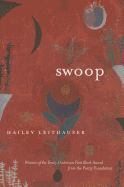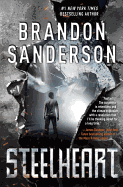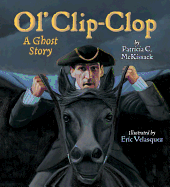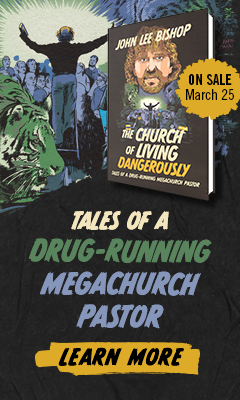Week of Friday, October 18, 2013
With her insightful, candid book Handling the Truth: On the Writing of Memoir (Gotham), author and teacher Beth Kephart puts herself in the shoes of aspiring writers and lifelong learners. She describes the very first writing class she took and recalls of the experience, "It would make me want to find a way to pass the knowing down." This book suggests that she's found the way.
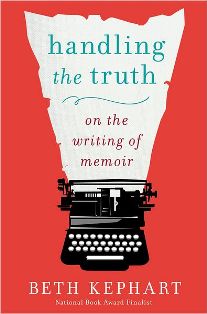 She shares with readers the texts that have taught her how to approach humor (such as Bill Bryson's A Walk in the Woods), childhood memories (The Liar's Club by Mary Karr; Autobiography of a Face by Lucy Grealy) and boundaries: "With Just Kids, Patti Smith teaches how much room memoir can make to preserve the integrity (and privacy) of others," Kephart writes.
She shares with readers the texts that have taught her how to approach humor (such as Bill Bryson's A Walk in the Woods), childhood memories (The Liar's Club by Mary Karr; Autobiography of a Face by Lucy Grealy) and boundaries: "With Just Kids, Patti Smith teaches how much room memoir can make to preserve the integrity (and privacy) of others," Kephart writes.
Kephart speaks candidly of her own journey, filled with growing pains and difficult life lessons, learned firsthand and by observing her students. Divided into four parts with large themes (e.g., "Raw Material," "Get Moving"), the book also includes subsections that allow readers to dip in and out and circle back as needed. She illustrates her points about perspective or setting with examples from fellow writers.
The first of her five memoirs was A Slant of Sun, a National Book Award Finalist; Kephart has also written young adult novels. She knows the difference between telling the truth and using truth as a kernel for fabricating fiction--and she asks her readers to parse these, too. She's astonishingly well read and explains precisely how each book she cites can serve as a guide along the way. "The job of a teacher, most of all (I think)," writes Kephart, "is to know what others have written and what another must read, right now, this second, in the midst of the long journey." --Jennifer M. Brown, children's editor, Shelf Awareness
More Things in Heaven and Earth
by Jeff High
Fresh out of medical school at Vanderbilt, Luke Bradford reluctantly takes up a post as the town doctor in Watervalley, Tenn. Though he longs for a research job at a prestigious hospital, Luke's extensive student loan debt and his small-town heritage propel him toward tiny, unsophisticated Watervalley. What he finds there--including a sharp-tongued housekeeper, a bitter recluse with a keen intellect and a muddy, affectionate stray dog--is both more challenging and more charming than he expected.
More Things in Heaven and Earth draws on Jeff High's medical experience in its deft portrayal of Luke's profession, with scenes ranging from infant vaccination to the resuscitation of a local farmer whose heart stops in the clinic's waiting room. Readers gradually learn Luke's history as he struggles to find his place in Watervalley, longing for connection but not willing to set down roots. Several comedic moments (some of them veering into slapstick) and a few not-so-dark town secrets provide relief from Luke's routine of seeing patients, until a baffling flu epidemic upends his life and leaves him both exhausted and determined to help his new community.
Though High's forays into Luke's inner life are often clumsy, even clichéd, his twin strengths lie in drawing likable, recognizable small-town characters and providing just enough medical detail in the clinic scenes. Watervalley is reminiscent of Jan Karon's Mitford or James Herriot's Yorkshire, and High's debut novel sets the stage for an enjoyable new series. --Katie Noah Gibson, blogger at Cakes, Tea and Dreams
Discover: The story of a reluctant small-town doctor in rural Tennessee makes for a charming debut.
Blood a Cold Blue
by James Claffey
The stories in James Claffey's Blood a Cold Blue are very short--most less than two pages long. A few are just a paragraph; some composed of a single, winding sentence. Each is a separate, fully realized morsel, and each is better than the last. It's hard to know where to pause for breath, but read them all at once and you run the risk of rushing past the luscious, inspired sentences and riveting imagery.
Many of the stories take place in Claffey's native Ireland. Others are set in his adopted home of California, or somewhere very much like it. In the U.S., Elvis's voice screeches from the radio and summer is "rippled and barbaric." The American stories have a bright, grotesque edge to them, distinct from the shimmering, surreal wonder of the Irish world that Claffey has "known and forgotten now, all this life-long later." His writing feels deeply autobiographical, and his narrators' voices ring with a hard-earned history. These are stories to savor and devour.
Claffey's lilting, circuitous prose blends an almost conversational tone with a Joycean attention to the malleable beauty of the written word. In "Ireland in Four Acts," he writes of "a cabin in Sligo, brass tub, the shining carapace of an old typewriter." A nameless writer will sit there and "vote for meaning, tap the ampersand." Claffey himself is in the business of "voting for meaning," of describing the joy and horror of life's bruised and bristling underbelly. --Emma Page, bookseller at Wellesley Books
Discover: A compelling, at times unsettling short story collection combining Irish and American literary sensibilities.
The Lion Seeker
by Kenneth Bonert
The epigraph to Kenneth Bonert's bold, ambitious debut novel, The Lion Seeker, comes from an 1884 report from Lithuania published in HaMelitz, a Hebrew journal. It describes a traveler going to South Africa "from our land, tired and weary of the oppressor." In Africa "he breathes a new life, a life of freedom and liberty, a life of wealth and honour." Here there is "no discrimination between a Hebrew and a Christian.... Every man can attend to his labours diligently and find a just reward for his toil." Perhaps.
The Lion Seeker deals with a mass exodus that few have heard about: in the late 19th and early 20th century, thousands of Jewish Lithuanians emigrated to South Africa in the hope of finding a new life. In Bonert's novel Abel Helger, a Lithuanian Jew from a shtetl in Dusat, arrived in the 1920s. The young man with a scuffling foot set up a modest watchmaking shop in Doornfontein, Afrikaans for "fountain of thorns." Later, his wife, the oddly veiled Gitelle, and their two children, Isaac and his sister, Rively, follow. On the day they left, Rively was quiet, Isaac was squirming. This bright five-year old, red-haired boy "hadn't stopped jerking and kicking from the second he came out of her."
In Cape Town Gitelle saw "human beings burned the color of coal or dark-brewed tea or cured leather." Johannesburg was two hot dry days north, pierced by that "red sun, a madman's glowering eyeball." They arrive at a self-made Jewish ghetto in the "baking dust of the deepest south." Abel has a shiksa girl to help with cleaning, cooking. "Is that what she calls it," Gitelle says; she fires her that afternoon and sets to work.
Isaac is our "hero" in this bildungsroman, but his mother, Gitelle, with the "dense power of her unmoveable being," is the most intriguing, the most mysterious. Behind her veil she is scarred, literally and figuratively--something happened in her past that she never talks about. Later, she saves enough money to have a procedure that gives her "half a mouth, half a scar." Burning her veil in the yard, she smiles at last.
One day she wields an axe on the couch that Abel's lazy, do-nothing friends always sit on, destroys it, chases them away. All the insults she has endured rip out of her in a fury; she calls them nochshleppers, kleps, kuylikers. Befitting a novel about many cultures, Bonert draws upon languages, words, phrases to help create his characters and their cultures, going back and forth from one to another: catty, moochoo, biltong, churuman, bladderfool, reinforcing his representation of the social complexity of individual worlds.
Isaac is Gitelle's Clever, "my boy, my beautiful," not a Stupid. She tells him he can't play with his friend Skots: "A Coloured is half of a Black. It's coffee in your blood. We are Whites. We are Jews but we are Whites here." People will try to stop you, but "you go forward and make and do." One day, Isaac brings home a puppy he took away from the Puppyman, who was going to kill it for food. Gitelle is furious: Where will they get the money for food, who will take care of it, this dirty animal makes diseases. "Nu, zog mir," she says. "Zog mir der richtike emes." So, tell me. Tell me the real truth. Isaac knows his mother is right--the dog has to go. "Today he's done like a Stupid." Isaac does her bidding, and continues to do so, with an unrelenting desire to please her, bring her family here, build her a house they can all live in together.
He goes to high school, which he hates. He lusts after a female teacher; one day at school he's caught masturbating with her nearby; he's expelled. Abel is mad; Gitelle says Isaac can work, earn money. Like Bellow's Augie March, Isaac ventures forth and begins his adventures in this complex world.
Always the entrepreneur, as a young boy he sold cold soda to drivers, but the lack of a license ended that. He takes a job supervising Black movers but another money-making plan he concocts backfires. He learns how to repair cars and partners with a schemer to sell scrap metal. Then he meets and falls in love with an upper-class English girl, always striving for more. The Second World War looms and Gitelle fears for her family in Lithuania, while Isaac is fearful of Nazi sympathizers in their midst.
The Lion Seeker is a powerful tale, beautifully told. Bonert's prose demonstrates sureness and confidence. At more than 500 pages, it's a long tale, and compelling. Mingling comedy and sadness, Bonert creates a huge world filled with many memorable characters. Like other great Jewish immigration epics, this novel has plot twists, surprises and unexpected revelations. He also posits a brooding mystery that hides in the dark. When you live for a while with Isaac--his family and his friends, in his South African world--you will come to appreciate Bonert's accomplishment, how he has been able to bring us along, entertain us, and move us in an authentic way that only a skilled writer can. --Tom Lavoie
Science Fiction & Fantasy
The Necromancer's House
by Christopher Buehlman
Christopher Buehlman (Between Two Fires) has given readers a spine-tingler in The Necromancer's House, wrapped in dark magic and a touch of folklore.
When the sexy but murderous rusalka (a Slavic water nymph) in the lake beside Andrew Blankenship's house claims a Russian widower as her latest victim, she draws an ancient and unstoppable evil down upon Andrew and his closest friends. Having spent the last few years in relative comfort, teaching witchcraft to a woman he met in AA and secretly loves, Andrew has more practice with youth spells and speaking to dead celebrities through VHS tapes than the magical artillery he'll need to survive a battle with a witch straight out of legend. To make it through the coming confrontation alive, he'll need to face his present, his past and the truth behind an entity he summoned and couldn't send back.
While Buehlman's chill-filled romp boasts entertainment value aplenty in the form of magical iPhone apps, deadly creatures and battles galore, its deeper layers explore the darker side of human nature--as all good horror must. Andrew's vices and vanity echo the imperfections that keep all of us from reaching our full potential, and an exploration of body-snatching echoes the loss of self that frightens everyone. Smart and scary, this seamless blend of horror and urban fantasy will satisfy thrill-seekers at Halloween--or any other time of year. --Jaclyn Fulwood, youth services manager at Latah County Library District and blogger at Infinite Reads
Discover: A modern-day warlock must find the strength to battle an ancient evil in Buehlman's atmospheric blend of horror and urban fantasy.
Ancillary Justice
by Ann Leckie
Ann Leckie's Ancillary Justice is a large, complex space opera with a brilliant take on identity and gender. All characters are described as "she," though several of them are expressly male, as the language of the far-future Radchaai does not distinguish between genders. Leckie builds a vibrant and colorful universe, inhabited by diverse human cultures and populations; nothing less of a setting would match the masterfully told plot that spans thousands of years, with an engagingly conflicted--and somewhat alien--character at its core.
One Esk, part of the sentient spaceship Justice of Toren, has a problem. As Breq, a foreign traveler on a secret mission, she has to avoid detection while facing overwhelming odds. The only surviving ancillary body of the ship mind, One Esk must somehow function as an individual, yet is unable to trust even the Radchaai emperor who may not have the citizens' best interests at heart. One Esk's only remaining task is one of vengeance, and perhaps even she is unaware of the reasons for it. And why, in the midst of all this, she chooses to help a minor captain from her earlier life is as confusing to her as her apparent need to sing all the time.
Leckie's debut novel introduces a fresh voice to "hard" science fiction, one that will continue with the next two planned novels in this series. --Rob LeFebvre, freelance writer and editor
Discover: A stunning, fast-paced debut set within a far-flung spacefaring empire in desperate need of a conscience.
Biography & Memoir
Saffron Cross: The Unlikely Story of How a Christian Minister Married a Hindu Monk
by J. Dana Trent
Dana Trent grew up in small-town Baptist churches and was ordained as a minister at the age of 21. She sometimes struggled with her faith, but her experience and worldview were solidly Christian. When she signed up with an online dating site, she could hardly imagine being matched with someone from a different background, and was astonished to be introduced to a former monk--a Hindu monk, at that.
Saffron Cross is Trent's account of the early years of her relationship with her husband, Fred, who had learned that while the monastic life didn't suit him, the spiritual practices of Hinduism certainly did. Learning to communicate across the gulf between their belief systems adds another layer to the everyday challenges of newlywed life, and at times Dana wonders whether they can make their interfaith marriage work without compromising their respective values. Eventually she realizes that her Christian spiritual journey is enriched, not diminished, by the influence of her husband's Hinduism.
Trent's story is one in which the personal is not so much political as it is interdenominational, and in the widest possible way. In Saffron Cross, she introduces readers to the Hindu beliefs and practices she has learned through Fred, and explores how they have reshaped and strengthened her own Christianity. Saffron Cross is not an interfaith marriage handbook, but as Trent relates how she and her husband have made their relationship work, it develops into a genuinely inspiring and enlightening story. --Florinda Pendley Vasquez, blogger at The 3 R's Blog: Reading, 'Riting, and Randomness
Discover: The unusual spiritual journey that results when a Southern Baptist minister marries a devout Hindu.
Current Events & Issues
Thank You for Your Service
by David Finkel
In The Good Soldiers, Washington Post writer David Finkel documented the lives of the men of Infantry Battalion 2-16 during a 15-month tour along the front lines in Baghdad. In Thank You for Your Service, Finkel continues to shadow the men as they return to the United States and battle post-traumatic stress disorder while struggling to reintegrate into domestic life. Finkel even follows the men into their homes and introduces the wives who deeply yearn for the men they knew and married before the deployment.
As Thank You for Your Service unfolds, the irony between promise and reality is never lost. The men arrive home to an overtaxed care system, a life of pills and uncertainty about the future. Finkel manages to earn enough trust from the soldiers to slip into the minutiae of their daily lives, observing and recording an exceptional narrative of veterans' disintegration within the throes of PTSD. The soldiers' personal struggles are a searing indictment of the existing support infrastructure and the toll that diminishing prospects have on shell-shocked families struggling to survive. If bitterness, stigma and shame are the sentiments greeting the soldiers' return from war, Finkel forces us to consider an alternative: that gratitude be returned in equal measure to the sacrifices they have given for the protection of our freedoms and for the liberties we continue to enjoy. --Nancy Powell, freelance writer and technical consultant
Discover: A heartbreaking portrait of soldiers returning from Iraq and Afghanistan coping with PTSD as they try to reintegrate into society.
Health & Medicine
Disease-Proof: The Remarkable Truth About What Makes Us Well
by David Katz
David Katz is trying to change U.S. culture--one body at a time. As an expert in chronic disease prevention and weight management, Katz (The Way to Eat et al.) knows preventive medicine begins with changing our habits. Disease-Proof focuses on guiding readers through concrete, attainable changes in diet and exercise: "lifestyle as medicine... no prescription required!" Katz also debunks the idea that our destiny is determined by our genes, believing they indicate only a possibility of risk that can be reduced by as much as 80% through healthy habits.
However, instead of emphasizing willpower, Katz believes we need more skill-power. He and his colleagues at Yale's Prevention Research Center have developed a "pressure system model" of behavior management that takes people's motivation and resistance to change into account. "If you want to change your habits, one approach is to try really, really hard," Katz writes. "The other is to follow the rules until that external discipline becomes internal discipline," transforming the healthy actions into "part of your personal skillset."
Each chapter begins with a challenge--such as not recognizing what healthy eating is--and describes the "right response" (learning to love foods that love us back), and "relevant skills" (portion control), after which Katz provides a to-do list focused on making the right choice easy. Even health-conscious readers would benefit from the fresh perspective on diet and exercise provided in Disease-Proof. --Kristen Galles from Book Club Classics
Discover: Dr. Katz believes we can overcome any obstacle to better health if we apply the right strategies and resources.
Reference & Writing
The Horologicon: A Day's Jaunt Through the Lost Words of the English Language
by Mark Forsyth
Are you lying awake before dawn, worrying about the day to come? Old English had a word for that: uhtceare. If your worries are too big, you may egrote, or feign sickness in order to avoid responsibility, and stay in bed, browsing Mark Forsyth's Horologicon.
Arranged in the chronological order of the average day, Forsyth's clever tome gathers dozens of the most poetic forgotten words in the English language. From the moment you throw on your pantofles (slippers) and stare blearily at yourself in the tooting-glass (mirror), through your morning aristology (the study of breakfast), the afternoon amell (lunch hour) and the doldrums in which your work is done frobly (indifferently well) at best, Forsyth offers a pitch-perfect way to describe your day.
Perhaps the most delightful element of The Horologicon is that, in addition to presenting some of English's most onomatopoeically apt and wonderfully versatile "lost words," Forsyth comments on their potential uses in ways that range from humorous to downright silly. Happily he does more than just list words like latrinogram (a rumor started in a lavatory), since most of us have a use for such terms, whether we care to admit it or not. After a trampoose (commute) through The Horologicon, few readers will see an ordinary day in quite the same way again. --Dani Alexis Ryskamp, blogger at The Book Cricket
Discover: A witty, lighthearted collection of "lost" English words, organized to run the course of an extraordinarily verbose day.
Poetry
Swoop: Poems
by Hailey Leithauser
After reading just two or three poems from Swoop, Hailey Leithauser's debut poetry collection, it's easy to see why this gathering of sleek, precise verse won the Poetry Foundation's Emily Dickinson First Book Award. The talent and craft exhibited here is cause for sheer glee. Leithauser has the rare ability to assemble phrases in such a way that the reader not only enjoys her facility with language but instantly recognizes the world depicted in her words, as her imagery clicks into perfect place.
Leithauser's agility of expression and biting sense of humor shine through, whether in a vignette of a discarded lover merrily torturing a voodoo doll of her ex or the imagined thoughts of a scythe longing to give its wielder a sharp caress.
More than once, Leithauser offers interludes on words "From the Grandiloquent Dictionary," lengthy or rarely used terms she plays upon so nimbly that readers may not come away with a definition of the word, but they will nonetheless have its essence. For example, in "Katzenjammer," whose title is a German word for a cat's wailing that may also mean any discordant sound or hangover, she encourages readers:
"Think of the yowl of three senile felines.
Think of a buzzsaw's black, sauerkraut whine.
Imagine ten screeched, unleashed violins.
Imagine the dawn that follows the gin."
Unfettered by allegiance to a single poetic form, Leithauser also shows her willingness to embrace both traditional rhymed forms and more playful experimentation with long, narrow slivers of verse that trickle down the page in a stream of upbeat rhythm. Here's hoping this confident and deft collection is the first of many from a powerful wordsmith. --Jaclyn Fulwood, youth services manager at Latah County Library District and blogger at Infinite Reads
Discover: This shrewd debut collection showcases Hailey Leithauser's precise and clever verse.
Children's & Young Adult
The Girl Who Soared Over Fairyland and Cut the Moon in Two
by Catherynne M. Valente, illus. by Ana Juan
At the start of this third book in Valente's Fairyland series, most readers will be just as eager as heroine September to find the way back to Fairyland and all of its marvelous and frightening things.
Alas, it is not to be, for on this adventure, September must go to the Moon. She first visits the town of Mercator with the cruel Blue Wind, where she learns a few secrets about money and is declared a Criminal and a Professional Revolutionary. Then, against her desires, September is on her way to the Moon in her beloved Model A Ford (who, as it turns out, is named Aroostook).
Many new friends aid September on her journey, and she discovers her mission may not be what she was told it was. And so, too, is the content of this third book different from the first two. September is, unknowingly, part of "the bustle of thirteen-year-olds becoming fourteen-year-olds," with all the confusion that implies. She rejoins her beloved A-Through-L, the Wyverary, and tangles again with her fate and her temper--but she also meets Ciderskin, the Yeti, and does battle with her self-identity and the choice of whether or not to fall in love. Though some readers may not be ready for the larger ideas tackled here, Valente's sumptuous writing fits readers of any age. For even as the tale grows darker, it is a pleasure to be immersed once more in the lives of the characters and places she so ably brings to life. --Stephanie Anderson, head of readers' advisory at Darien Library and blogger
Discover: Catherynne M. Valente's third book in what is fast becoming one of the best fantasy series of the 21st century.
Steelheart
by Brandon Sanderson
What if the supers from The Incredibles were real? But instead of fighting bad guys, they were the bad guys? That's the question posed by Brandon Sanderson's Steelheart, the first in a trilogy.
Ten years ago, David watched his father murdered by Steelheart in a bloody bank robbery. As an Epic superhuman, Steelheart was deemed invincible. But David saw the Epic bleed that day, and he's the only human alive who knows that Steelheart has a flaw. Now 18, David has spent the past 10 years studying the Epics and learning their weaknesses and their patterns. Every Epic has a distinct power, but David has discovered that every Epic also has a fatal flaw. He joins up with the Reckoners, humans who are the only armed insurgents foolish enough to challenge the Epics. David must convince the group he has a plan that will bring down the Epics one by one, until they can take on Steelheart.
Adult author Sanderson (the Wheel of Time series) delivers a thrilling YA debut. He creates interesting, multidimensional bad guys, and the good guys (especially David) evolve throughout the story. The author moves from battle to battle, deepening the characters as he goes. In a crowded space of dystopian adventures, Sanderson gives readers a fresh, exciting story fueled by adrenaline. This plot-driven fantasy with a sympathetic teen protagonist and a powerful love interest will lure even reluctant readers. It's a confection with enough high-tech gadgetry and action sequences to keep everyone entertained and waiting for more. --Nan Shipley, literary scout
Discover: Brandon Sanderson's YA debut is a fast-paced thrill ride and should appeal even to reluctant readers.
Ol' Clip Clop
by Patricia McKissack, illus. by Eric Velasquez
With the cadence of a true storyteller, Newbery Honor author Patricia McKissack (The Dark-Thirty) describes a haunting to rival the headless horseman, in time for Halloween and just right for a year-round fright.
It's Friday the 13th in October 1741 New England, and John Leep shuts his shop early in order to toss out his tenant, the widow Mayes. The thought makes him smile. "Smiling didn't come easy to a man like John Leep," writes McKissack, "He had a mean streak in him that ran the length of his long, thin body." Eric Velasquez depicts the landlord in a suspicious-looking posture, engulfed by dusk shadows. En route on his steed, John Leep hears someone in pursuit ("Clip. Clop. Clip. Clop"), yet finds no one behind him each time he turns around. Still, whenever he resumes his ride, he hears "the muffled sound of another horse's hooves."
McKissack's skilled pacing and eerie refrain build the tension as Velasquez deepens the darkness; only John Leep's stricken face and white ruffled collar and cuffs reflect the moonlight. At the door of the widow Mayes, the artist uses golden light to convey the woman's kindness as she hands over her rent. Leep's fear sends the money skittering across the floor. The suspense mounts as he retreats (Clippity-cloppity, clippity-cloppity, clippity-cloppity"), and readers can predict that justice will be done. Velasquez's final terrifying image will linger in readers' minds. This will be a favorite read-aloud all year long. --Jennifer M. Brown, children's editor, Shelf Awareness
Discover: A frightful picture book read-aloud from master storyteller Patricia McKissack.
| the church of living dangerously |
|


